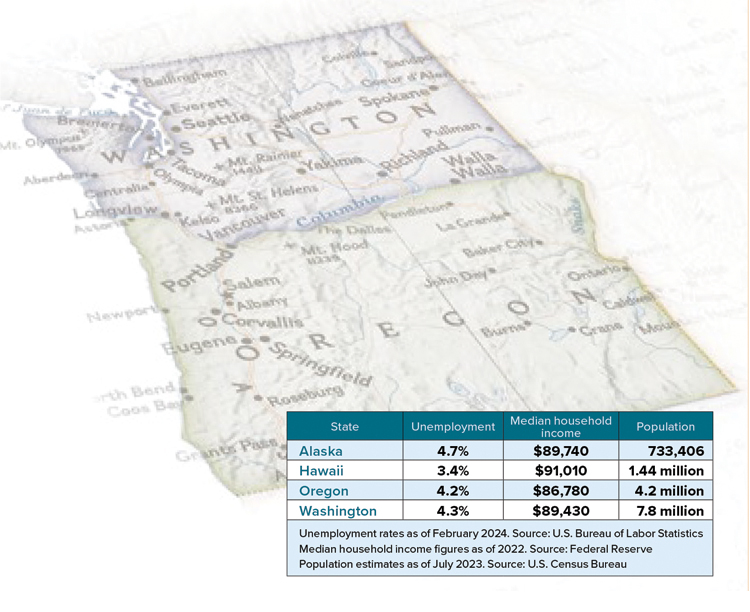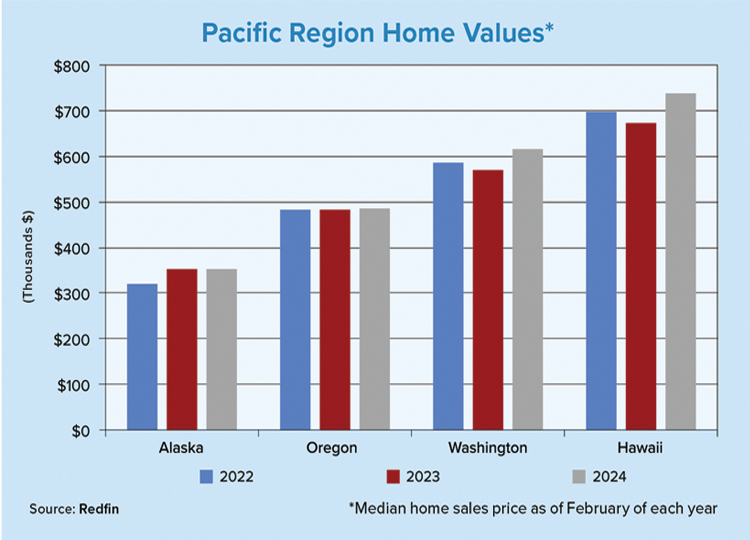More than 50 years ago, Oregon pioneered a set of laws aimed at curbing urban sprawl while conserving nature and agricultural lands. The so-called urban growth boundary requires cities statewide to forecast growth once every 20 years and only allows expansion if cities can prove that the area inside the boundary can’t accommodate the projected needed new homes, businesses and public facilities.
The law is credited with preserving open spaces that in other states have been flooded with a sea of strip malls and subdivisions. But Oregon, like the other states in the Pacific Region — including Washington, Hawaii and Alaska — is facing a housing affordability crisis.
This year, The Beaver State lawmakers chipped away at the law, allowing cities a one-time exception to add expansions of 50, 100 or 300 total acres depending on city size with an eye at alleviating the housing crunch. (Washington and Tennessee are the only other states that have similar statewide urban growth boundaries, although several cities have them including Honolulu.)
Whether these expansions will solve Oregon’s housing affordability problems remains to be seen. But the problem is clear, despite the fact that Oregon, Alaska and Hawaii all lost population between 2021 and 2022.
The four states in the region rank among the least affordable in the nation for both cost of living and housing affordability, according to a U.S. News & World Report ranking. Alaska ranked No. 40 on the list followed by Oregon at No. 41, Washington at No. 42 and Hawaii at No. 49. All the states ranked in the bottom half of the country for housing affordability with Washington coming in at No. 44 and Hawaii at No. 49.

The economies of these four states vary widely. Washington and Hawaii benefit greatly from tourism ranking 12th and seventh nationally, according to Yahoo Finance. Washington ranks No. 2 nationally and Oregon No. 4 nationally in wine production, producing 35.6 million and 10.9 million gallons per year. Washington ranks fourth in the nation for number of craft breweries while Oregon ranks No. 12.
All the states rely heavily on natural resources extraction as well as agriculture. Washington, for instance, produces more than half of the nation’s apples that are grown each year.
Alaska has traditionally brought in nearly a third of the total value of commercial seafood production in the U.S. although snow crab season being cancelled two years in a row has hit the state hard. Hawaii ranks No. 1 in the nation in both coffee and macadamia nut production, the latter being the state’s leading cash crop. Nearly 100% of all the nation’s hazelnuts produced commercially are grown in Oregon’s Willamette Valley.
Washington is home to some of the largest companies in the world including Microsoft, Starbucks and Costco. (Boeing, an Evergreen State mainstay, moved its headquarters years ago to Chicago and just last year to the Washington, D.C. area. Amazon is splitting its headquarters between Seattle and the D.C. area.) Oregon boasts Nike and commercial vehicle manufacturer Daimler Truck.
Washington ranks No. 10 in the nation with $738 billion of gross domestic product, the total sum of all goods and services produced in the state, according to the U.S. Bureau of Economic Analysis. Oregon ranks No. 25 at $297 billion while Hawaii is No. 40 at $101 billion and Alaska ranks No. 48 at $65.7 billion. ●

All the states in the Pacific Region face a housing affordability crisis, according to an analysis by Forbes magazine. The analysis looks at average home prices, property taxes and median household income. Hawaii ranks No. 1 for least affordable in the nation with average home prices at $730,000 and a household income at $81,000.
Washington ranked No. 4 in the nation with average home prices at $431,000 and a median household income of $74,000. Oregon ranked No. 7 ($374,000 and $63,000.) And Alaska comes in at No. 12 ($300,000 and $78,000 respectively.) One study by the Building Industry Association of Washington found that 84% of Washington families cannot afford to purchase a home in The Evergreen State.
All the states in the region had housing supply problems with a limited number of active listings, according to Realtor.com. Washington ranked No. 22 in the nation with 9,476 listings in February followed by Oregon at No. 24 (8,220), Hawaii No. 36 (3,836) and Alaska ranked No. 48 (1,089). The latter two with smaller populations may be unsurprising, however.
What the Locals Say
We used to joke that The New York Times had a crush on Portland. They would run articles about the food, the wine, the scene and the hipsters and the whole thing. Portland was the darling of the media. And I was helping people move here.
As much as Portland has become, I think, unfairly the poster child for the issues that a lot of big cities are struggling through — homelessness and the opioid crisis — those are ills that are going on everywhere. What’s lost in that is this is still an amazing place to live with an incredible quality of life.
Every week I talk to clients who are relocating to Portland from other cities on the West Coast who are moving here because it’s more affordable and because the quality of life is nicer and it’s where they wanna raise a family.
We started the year in Portland with a debilitating ice storm. It sounds like a silly thing to talk about, but even if we have a snowstorm, that can slow the market. When you have an ice storm and people are trapped at home and their pipes are bursting, it’s a whole thing.
I’m optimistic for the year. We’re hitting our stride. I talked to a couple friends the other night, and we all are preapproval machines right now. Higher interest rates for the past two years pushed transactions into the future. People deferred buying, deferred selling, deferred moving. You can delay a move or a home purchase for a while, but at a certain point life goes on.

Branch manager
Guaranteed Rate
Sources: Boeing, Brewers Association, Building Industry Association of Washington, Business Insider, CBS News, Federal Reserve, KHON-TV, National Oceanic and Atmospheric Administration, Oregon Capital Chronicle, Realtor.com, Tennessee Department of Economic and Community Development, The Associated Press, U.S Bureau of Economic Analysis, U.S News & World Report, U.S. Bureau of Labor Statistics, U.S. Census Bureau, U.S. Department of Agriculture, WineAmerica, Yahoo Finance








